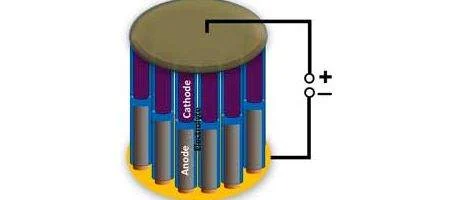Rice University researchers say they’ve been able to pack an entire lithium ion energy storage device into a single nanowire – as small as such devices could possibly get.

They could be valuable as a rechargeable power source for new generations of nanoelectronics, they say.
Professor Pulickel Ajayan’s team has tested two versions of the battery/supercapacitor hybrid. The first is a sandwich with nickel/tin anode, polyethylene oxide (PEO) electrolyte and polyaniline cathode layers.
It was built to demonstrate that lithium ions would move efficiently through the anode to the electrolyte and then to the supercapacitor-like cathode. This stores the ions in bulk and gives the device the ability to charge and discharge quickly.
The second version packs the same capabilities into a single nanowire. The researchers built centimeter-scale arrays containing thousands of nanowire devices, each about 150 nanometers wide.
In previous work, the team’s made three-dimensional nanobatteries in which the nickel-tin anode was encased, but the cathode had to be attached on the outside.
The new process tucks the cathode inside the nanowires, says Ajayan. The researchers used PEO as the gel-like electrolyte to store lithium ions and act as an electrical insulator between nanowires in an array.
After much trial and error, they settled on an easily synthesized polymer known as polyaniline (PANI) as their cathode.
The team’s experimental batteries are about 50 microns tall – about the diameter of a human hair. Theoretically, they can be as long and wide as the templates allow.
The devices show good capacity, says the team; the researchers are nowfine-tuning the materials to increase their ability to repeatedly charge and discharge, which now drops off after a about 20 cycles.
“There’s a lot to be done to optimize the devices in terms of performance,” says chemical engineering graduate student Sanketh Gowda.
“Optimization of the polymer separator and its thickness and an exploration of different electrode systems could lead to improvements.”






